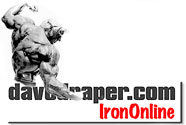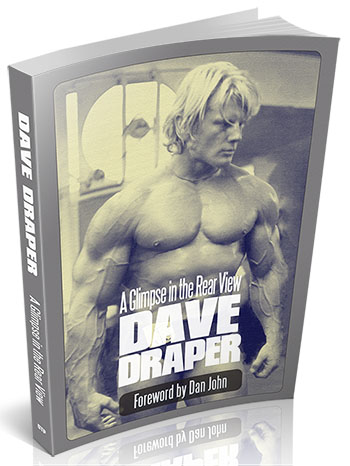What Was It Like in the Golden Era?

Download the full Draper here newsletter
in printable, live-link, pdf format, here.
I was sitting on a park bench in the middle of the afternoon when some guy comes up to me and sez, “Hey, you Dave Drapeless?”
To which I respond, “Pretty much.”
He then asks me if it’s okay to sit down and ask me some questions, to which I respond, “Sure, it’s a free country.”
We get talkin’ and this is how it went.
Q: What was it like at Gold’s back in the 1970s?
It was in the shadows of the Muscle Beach Dungeon’s spare lighting that I learned all I know about building muscle and power. There the seed I brought from the streets of Jersey in ’63 took root, grew deep and bore a decent yield. I won Mr. America and Mr. Universe.
I then joined Joe Gold’s gym in Venice in 1966 and continued to lift weights with quiet passion. But for an occasional burst of training when a special occasion prompted me to work out twice a day (posing exhibition, inner urges, the 1970 Mr. World), I was in and out of the gym by 8 AM. Those two hours, six days a week, were major events internally, but on the outside they were as ordinary as toast.
In the late ’60s Frank Zane made his home in Venice and our workouts conveniently overlapped. Arnold appeared in California, with Franco close behind, and made his way to Joe’s original Gold’s in ’68. Ken Waller joined the group at a corresponding time, and various seasons of the year brought champs from the corners of the world for a plunge in the West Coast bodybuilding scene. Rick Drasin, Denny Gable, Bill Howard, Dan Howard, Chet Yorton, Bill Grant and Superstar Wayne Coleman are some of the tanned and sand-dusted faces I see fondly in my memory.
Zabo ran the place and became known as the Chief. Eventually, Eddie Giuliani headed the gym’s secret service dept.
Q: What was the atmosphere like?
I offer a narrow picture of “training at Gold’s” during the ’70s. For all intents and purposes, competitive bodybuilding was behind me. In fact, I resumed the role I never left -- lifting weights for muscle and might and the fulfillment and pleasure it offered. In ’n out, like the hamburger joint, and off to make odd, oversized furniture from pier wood. That’s me.
The best times I recall at the original Gold’s were the summer days of 1970. There were a series of competitions in the fall and five of us were preparing for the shows: Frank, Franco, Arnold, Katz, Zabo, Holland’s Serge Jacobs and me. We trained twice a day and at least one of those daily sessions was together.
The days were exciting, yet serene. The workouts were focused and intense, yet loose and easy. The gym floor was some 2,000 square feet of benches and platforms, pulleys and racks, iron and bars. No radio. The sounds came from moving bodies, shuffling benches, jangling weights, groaning lifters and muted thuds. We conversed, no one chattered; we laughed, no one sniveled; we barked, no one bit.
The weights moved in the direction they were urged, and we grew.
One July evening stands out above the rest. Artie Zeller, one beautiful guy, carried his camera around the gym like a stealth pilot. He was there, but under the radar, silently exposing film at just the right moment. The gym was simmering, each of us off in different directions. Frank was benching, Mike Katz was doing pulldowns, Franco was doing barbell rows, and Arnold and I were squatting. Not a false move was made. We appeared like moths around a nightlight, we moved tons of iron like cranes, and we encouraged each other with authentic and willful persuasion, and a strong arm when needed.
And the best part -- aside from the fact that it’s in black and white -- we never viewed each other as competitors, challengers or rivals. No revolting egos. No one wore designer gear, carefully torn sweatshirts and look-at-me low-slung tank tops. We were all unique with strengths and weaknesses to overcome, aches and pains to endure, and hopes and dreams to realize. We were friends of an unusual cut.
Not that we considered it a very special thing, but we were a rare breed of musclebuilders yet to be displayed, yet to be archived and yet to be imitated.
Time moved on, the gym’s location and ownership changed and the core dispersed, lost cohesion and became diluted by the crowd. That’s what time, people and things do.
Q: What were some of the problems you encountered as a bodybuilder back in those times?
There was no problem in identity. I was impervious to the misunderstandings from the average folks around me. I, in fact, enjoyed the distinction from those to my right and left. There were so few top names in the ’60s, you knew them all: Howorth, Pearl, Scott, Gironda, Zane, Yorton, Zabe, the local guys, and Ortiz, Poole, Ferrigno, Abbenda, Boyer. Each was a mystery, each an inspiration, each a friend.
Being a top bodybuilder was easier once you got past discovering the sport, becoming fascinated with it, and engaging it with passion and zeal long enough to understand it and achieve some muscle and might.
The rest was hard work, sacrifice, perseverance, time, patience, commonsense and luck.
Q: Who were some of the more entertaining Gold’s members?
Each lifter was a character upon which a book could be written. That includes the mild nutsos no one ever heard about, the Joes, Bobs and Amys, fewer Amys than Bobs.
Zabo, his workout complete by dawn, sat in his shorts and flip flops with the sun on his back as he read an important paperback. “What’s it all mean?” was his philosophy and answer to all questions. No one got past the Chief without a terse comment that summarized the day. Shut up and train.
Superstar Wayne Coleman strode into the gym with no bones to pick or bodies to toss. He specialized in heavy bench presses, dumbbell presses at the far end of the rack and an attitude as soothing a Tupelo honey. He was like quiet, distant thunder.
Arnold and Franco were a pair, two restless race horses in the starting block with an absolutely fundamental approach to training and life. They seemed to ride their own wave -- the crest, really -- and they a pair of middle European decent. Come on in, the water's fine. In fact, it’s fantastic.
Frank Zane slipped in at daybreak and we supported each other with pullovers and presses and endless gut work. We spoke silently and incessantly, and the communication was ideal. What went on between our ears and minds is anyone’s guess. We never missed a workout, seldom a set or rep.
Joe Gold cruised the gym -- his creation, his humble palace, his emerging empire -- spoke little and said a lot. He observed the muscleheads in their passionate and aimless activities, devising ways to make them more productive and palpable. Bigger pulleys, deeper racks, thicker handles… whadaya think?
Q: Sounds like a great time. Why’d you drop out?
The early ’60s were a mild time in bodybuilding. I trained hard in the Dungeon and worked regularly for Weider in his pint-sized office and shipping department. I had a young wife and daughter, no dough, lots of promise and promises and was busy with daily survival. There was some TV, a few side jobs to pay the bills and I had some friends in both Vince’s gym (Howorth, Scott, McArdle) and the Dungeon (Zabo and the rest of the neat local lifters). We had lifting in common; it was the bond, but we didn’t talk about training or nutrition or muscles -- shop talk -- when we hung out and played and explored.
At the same time there was a sharpening rise in bodybuilding interest as the ’60s progressed. Three or four big Weider shows in New York smack in the middle of the ’60s set things off: the Mr. America, Mr. Universe shows and the Mr. Olympia. The zealous NY audience started a stampede. Sergio arrived on the bodybuilding scene, Arnold was in California toward the end of the decade and the launching pads were ready.
In the ’70s we saw bigger magazines, more coverage, and greater participation in the gyms, contests and audiences worldwide. Musclebuilding became an industry overnight. Hello, Pumping Iron.
At the stir of this phenomenon I resisted and returned to lifting for the same reasons I began as a snotnose kid 15 years earlier: for its calm truth and simplicity, pain and fulfillment, muscle and might.
I was not the star type nor a muscleman groupie. Thus, I did not submerge myself in the developing bodybuilding world of the ’70s. I performed my delicious musclebuilding out of sight of the crowd and its crowd-pleasers.
With that my new found friend sez, “Gotta run, Drapster,” and heads off. I’m walkin’ back the way I came, thinkin’ there’s a lot more to tell. If that dude doesn’t get a day job, maybe I’ll see him again and we can talk some more.
DD
Want a little more of the Gold’s Gym summer of 1970 story? Here’s Dick Tyler’s telling of that remarkable summer.
To order this book of Golden Era memories, here’s your direct link.
*****
Take a trip over to our
Musclebuilding Q&A Blog
... where Dave allows us a peek into his email outbox.
Did you sign up for Dave's expanded email yet?
It's free, motivating and priceless!
We'll also send you a link to Dave's free
Body Revival Tips and Hints e-report with your confirmation notice.

